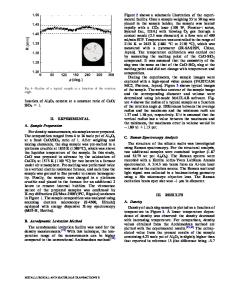Effect of pore generator on microstructure and resistivity of Sb 2 O 3 and CuO doped SnO 2 electrodes
- PDF / 1,284,993 Bytes
- 8 Pages / 595.276 x 790.866 pts Page_size
- 4 Downloads / 329 Views
Effect of pore generator on microstructure and resistivity of Sb2O3 and CuO doped S nO2 electrodes M.‑J. Sánchez‑Rivera1 · A. Gozalbo1,2 · V. Pérez‑Herranz3 · S. Mestre1,2
© Springer Science+Business Media, LLC, part of Springer Nature 2020
Abstract Sb2O3 and CuO doped SnO2 ceramic electrodes could be an alternative to the ones currently used ones in the electrooxidation process of water pollutants. The rise of electrode surface by introducing a porogen agent on the composition was analysed in order to increase the electrochemical active surface. For this reason, several substances were tested. Although the densification and total pore volume had similar values, the microstructures and the pore size distributions generated were strongly dependent on porogen nature. A total of five porogens were tested, but petroleum coke turned out to be the best option for these electrodes. It was found that the electrical resistivity depends on the nature of pore generator. Furthermore, its relation to the porosity can be modelled with Archie’s or Pabst’s equations. Keywords Electrode · Sintering · Porosity · Microstructure · Electrical conductivity
1 Introduction One of the most important alternatives to eliminate water contaminants is the electrooxidation process. A chemical reaction takes place on the anode surface, generating hydroxyl radicals that allow the complete mineralization of organic pollutants [1]. However, the highly oxidizing environment requires anodes which withstand a chemical attack. Therfore, currently used electrodes are based on titanium oxides as well as tin-doped indium oxide [2], tin oxide doped with fluorine [3] or boron-doped diamond [4]. One of the main disadvantages of those electrodes is their high cost, either by the scarce elements that they include or by the expensive techniques needed for their manufacturing. Nevertheless, recent studies show that antimony and copper doped tin oxide electrodes processed by the traditional ceramic method can be a good option to replace the current anodes used in the electrooxidation process. In this way, * M.‑J. Sánchez‑Rivera [email protected] 1
Instituto Universitario de Tecnología Cerámica, Universitat Jaume I, Castellón, Spain
2
Departamento de Ingeniería Química, Universitat Jaume I, Castellón, Spain
3
Departamento de Ingeniería Química y Nuclear, IEC Group, Universitat Politècnica de València, Valencia, Spain
recalcitrant and emergent contaminants from wastewaters can be removed [5]. The main component of the alternative electrode, tin oxide, is an n-type semiconductor used in a wide range of chemical and electronic applications [6–12]. Despite this, it is also recognized for its poor sinter ability [13]. It is the main drawback of its processing, although it is possible to improve their densification through some additives as ZnO, CeO2 or In2O3 [14–16]. In a previous work, the authors tested copper oxide as sintering aid since many researchers had successfully tested it on SnO2-based anodes used in the manufacture of a
Data Loading...










